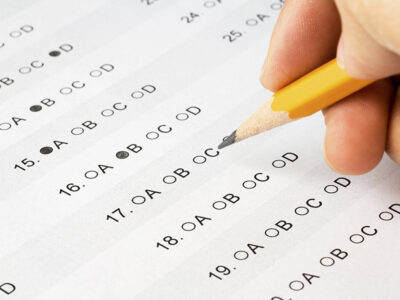I have some good news for you.
If you’ve mastered linear equations, you’re already 75% of the way to understanding linear inequalities. (Okay, okay…. I’m not sure about the 75% exactly, but you’re pretty close, alright?!). That’s good news because there’s plenty of other math topics to master when preparing for the SAT.
If you need a linear equation refresh, jump over there first, then come back to tackle linear inequalities.
Kickstart Your SAT Prep with Test Geek’s Free SAT Study Guide.
What is a Linear Inequality?
Have you ever thought about what the term “inequality” means? Inequality literally means “not equal,” and that’s exactly what’s going on with mathematical linear inequalities. One side does not equal the other. Instead of an equal sign (=), we have greater than (>) or less than (<) signs to work with.
While linear equations give us one distinct answer like x = 5, linear inequalities give us a range of where our answer can be found.
With a linear equation, you’ll end up with a single answer. Something like x = 1. If we plot x=1 on a number line, it looks like this:

But what if x > 1? In this case, we’re saying x could be any number greater than 1. Not 1 itself, but any number greater than 1. We could plot it on a number line like this:

When we use an inequality like this, we’re referring to a range of values instead of just one value.

Inequality Signs to Know for the SAT
To be able to solve linear inequalities on the SAT, you need to know the following inequality signs:

How to Solve Linear Inequalities
For the most part, you can treat linear inequalities just like linear equations. Key word is most. So, what’s the exception? If we divide or multiply by a negative number, we have to flip the sign of the inequality.
Rule: Flip the sign when you multiply or divide by a negative number.
Let’s look at an example.
Example 1:

First, we should recognize this as a linear inequality equation because of the inequality sign (>) rather than an equal sign.
We’re going to solve this just as we would solve a linear equation question: isolate x.

Add 3 to both sides.

Divide by 5.

We’ve solved the linear inequality, but now we need to return back to our question and see what it’s asking for.

It asks for a possible value. Because we are dealing with an inequality, x could be any number in a range of values, and the SAT wants us to identify which answer choice is in that range.
Think to yourself: if x has to be greater than 2, what is one possible value that x could be? Any number that is greater than 2, so… 3, 4, or 5.
At this point you would take a look at your answer choices and determine which one is greater than 2. Our answer will be D.
Nicely done.
Example 2:

Divide both sides by -6. Remember our rule here. Because we are dividing by a negative number, we must flip the sign.

Draw a quick graph if it helps you to visualize it.

We’re looking for an answer choice that is greater than 3, so our answer will be B.
Example 3:

Start by isolating x. Add 6 to both sides.

Now, we need to get all the x’s on one side, so let’s subtract 3x from both sides. We could, alternatively, subtract 8x from both sides but then we would be dealing with negative numbers and we’d have to move the 1 back over to the both side. Subtracting 3x from both sides is the simpler option.

Divide by 5.

Notice that we haven’t divided or multiplied by a negative number, so our sign stays the same.
Great, we have solved for x. Sometimes it can be easier to think about inequalities when the variable is on the left side, so we can switch it around if we want to.

It’s always a good idea to read it in sentence form in your head: “x is less than or equal to 1/5.”
So, back to our question.

The answer must be D because all the other options are less than or equal to 1/5.

What would 200 EXTRA POINTS do for you? Boost Your SAT Score with Test Geek SAT prep.
Systems of Linear Inequalities
Occasionally, you’ll see more challenging linear inequality questions in the form of systems of linear inequalities based on real-world situations (in other words: word problems). At most, you’ll see 1 of these questions on the SAT, so before proceeding, make sure you’ve spent ample studying other, more common question types.
If you’re looking for a perfect score on the SAT math (or close to it), you’ll certainly need to master these question types.
Let’s look at an example.
Example 4:
Samantha owns a dessert shop that sells cakes and pies. Cakes sell for $40 each and pies sell for $25 each. Last week her goal was to sell at least 30 total desserts. If Samantha met her goal and sold over $1000 worth of cakes and pies combined, which of the following systems of inequalities describes c, the possible number of cakes Samantha sold last week?

Samantha sold c cakes and p pies last week. She met her goal of selling at least 30 total desserts, so the sum of c and p must be greater than or equal to 30.

Only B and C contain this inequality, so we can eliminate A and D.
Each cake sells for $40, and each pie sells for $25. Samantha brought in 40c dollars from selling cakes and 25p from selling pies.
Since Samantha sold over $1000 worth of cakes and pies, the sum of 40c and 25p must be greater than 1000.

So, the correct answer choice is C.
Notice that in this question, you aren’t being asked to actually solve the inequalities. Instead, you’re being tested on your ability to translate a word problem into mathematic inequality expressions.
When it comes to linear inequality word problems on the SAT, this is the most common type you will see. Very rarely would you be asked to actually solve the inequalities.
Final Thoughts
For the SAT, you need to be familiar with inequality signs, how to use your linear equation-solving skills to solve linear inequalities, and how to translate word problems into linear inequality expressions.
Take the time to strengthen your linear equation skills first. Then, tackle linear inequality practice questions to master this SAT topic.









Comments